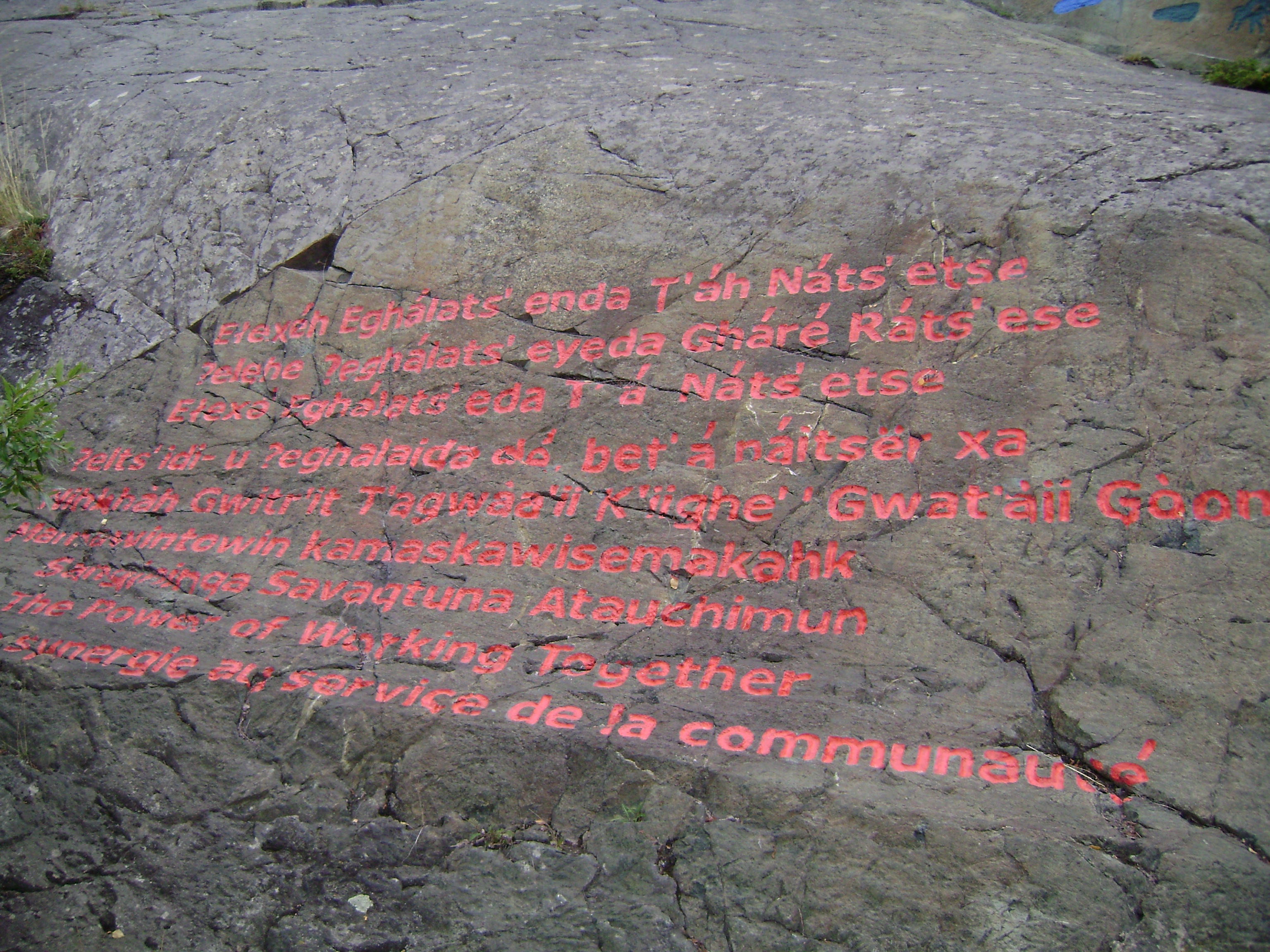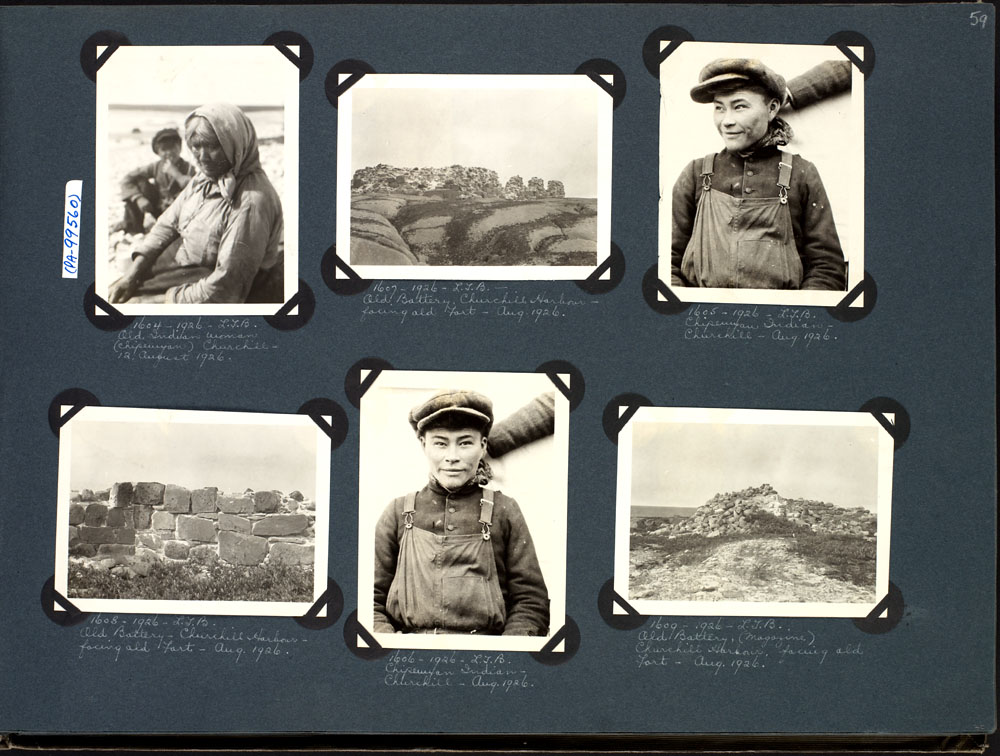|
Catherine Beaulieu Bouvier Lamoureux
Catherine Beaulieu Bouvier Lamoureux ( – 1918) was a Métis women living in the Northwest Territories. She was a founder and leader of the local Métis community. The daughter of François Beaulieu II and Louise (or Catherine) St. Germain, she was born in the Salt River region near Fort Smith. In 1845, she was baptized into the Roman Catholic Church and attended the Grey Nuns school in St. Boniface. The Grey Nuns founded a hospital and school in Fort Providence in 1867 and she encouraged First Nations women to use their health care services. Beaulieu spoke several languages Chipewyan, Cree, Michif and Slavey. She is believed to be the source of the Chipewyan oral history recorded by Fathers Émile Petitot and Grouard. She also helped to preserve oral tradition for her own people. She was married twice: first to Joseph Bouvier in 1852 - he died in 1877 - and then, in 1879, to Jean-Baptiste Lamoureux. She died at Fort Providence in 1918 after the death of her second husband ... [...More Info...] [...Related Items...] OR: [Wikipedia] [Google] [Baidu] |
Métis
The Métis ( ; Canadian ) are Indigenous peoples who inhabit Canada's three Prairie Provinces, as well as parts of British Columbia, the Northwest Territories, and the Northern United States. They have a shared history and culture which derives from specific mixed European (primarily French) and Indigenous ancestry which became a distinct culture through ethnogenesis by the mid-18th century, during the early years of the North American fur trade. In Canada, the Métis, with a population of 624,220 as of 2021, are one of three major groups of Indigenous peoples that were legally recognized in the Constitution Act of 1982, the other two groups being the First Nations and Inuit. Smaller communities who self-identify as Métis exist in Canada and the United States, such as the Little Shell Tribe of Chippewa Indians of Montana. The United States recognizes the Little Shell Tribe as an Ojibwe Native American tribe. Alberta is the only Canadian province with a recognized Métis Nati ... [...More Info...] [...Related Items...] OR: [Wikipedia] [Google] [Baidu] |
Slavey Language
Slavey (; also Slave, Slavé) is a group of Athabaskan languages and a dialect continuum spoken amongst the Dene peoples of Canada in the Northwest Territories – or central Denendeh – where it also has official status.Northwest Territories Official Languages Act, 1988 (as amended 1988, 1991-1992, 2003) The languages are primarily written using a modified , with some using Canadian Aboriginal syllabics. In their own languages, these languages are referred to as: Sahtúgot’įné Yatı̨́ (spoken by the [...More Info...] [...Related Items...] OR: [Wikipedia] [Google] [Baidu] |
Date Of Death Missing
Date or dates may refer to: *Date (fruit), the fruit of the date palm (''Phoenix dactylifera'') Social activity *Dating, a form of courtship involving social activity, with the aim of assessing a potential partner **Group dating *Play date, an appointment for children to get together for a few hours * Meeting, when two or more people come together Chronology * Calendar date, a day on a calendar ** Old Style and New Style dates, from before and after the change from the Julian calendar to the Gregorian calendar ** ISO 8601, an international standard covering date formats *Date (metadata), a representation term to specify a calendar date **DATE command, a system time command for displaying the current date *Chronological dating, attributing to an object or event a date in the past **Radiometric dating, dating materials such as rocks in which trace radioactive impurities were incorporated when they were formed Arts, entertainment and media Music *Date (band), a Swedish dans ... [...More Info...] [...Related Items...] OR: [Wikipedia] [Google] [Baidu] |
Persons Of National Historic Significance (Canada)
A person ( : people) is a being that has certain capacities or attributes such as reason, morality, consciousness or self-consciousness, and being a part of a culturally established form of social relations such as kinship, ownership of property, or legal responsibility. The defining features of personhood and, consequently, what makes a person count as a person, differ widely among cultures and contexts. In addition to the question of personhood, of what makes a being count as a person to begin with, there are further questions about personal identity and self: both about what makes any particular person that particular person instead of another, and about what makes a person at one time the same person as they were or will be at another time despite any intervening changes. The plural form "people" is often used to refer to an entire nation or ethnic group (as in "a people"), and this was the original meaning of the word; it subsequently acquired its use as a plural form of per ... [...More Info...] [...Related Items...] OR: [Wikipedia] [Google] [Baidu] |
Date Of Birth Uncertain
Date or dates may refer to: *Date (fruit), the fruit of the date palm (''Phoenix dactylifera'') Social activity *Dating, a form of courtship involving social activity, with the aim of assessing a potential partner **Group dating *Play date, an appointment for children to get together for a few hours * Meeting, when two or more people come together Chronology *Calendar date, a day on a calendar ** Old Style and New Style dates, from before and after the change from the Julian calendar to the Gregorian calendar ** ISO 8601, an international standard covering date formats *Date (metadata), a representation term to specify a calendar date **DATE command, a system time command for displaying the current date *Chronological dating, attributing to an object or event a date in the past **Radiometric dating, dating materials such as rocks in which trace radioactive impurities were incorporated when they were formed Arts, entertainment and media Music *Date (band), a Swedish dansb ... [...More Info...] [...Related Items...] OR: [Wikipedia] [Google] [Baidu] |
1918 Deaths
This year is noted for the end of the World War I, First World War, on the eleventh hour of the eleventh day of the eleventh month, as well as for the Spanish flu pandemic that killed 50–100 million people worldwide. Events Below, the events of World War I have the "WWI" prefix. January * January – 1918 flu pandemic: The "Spanish flu" (influenza) is first observed in Haskell County, Kansas. * January 4 – The Finnish Declaration of Independence is recognized by Russian Soviet Federative Socialist Republic, Soviet Russia, Sweden, German Empire, Germany and France. * January 9 – Battle of Bear Valley: U.S. troops engage Yaqui people, Yaqui Native American warriors in a minor skirmish in Arizona, and one of the last battles of the American Indian Wars between the United States and Native Americans. * January 15 ** The keel of is laid in Britain, the first purpose-designed aircraft carrier to be laid down. ** The Red Army (The Workers and Peasants Red Army) ... [...More Info...] [...Related Items...] OR: [Wikipedia] [Google] [Baidu] |
1820s Births
Eighteen or 18 may refer to: * 18 (number), the natural number following 17 and preceding 19 * one of the years 18 BC, AD 18, 1918, 2018 Film, television and entertainment * ''18'' (film), a 1993 Taiwanese experimental film based on the short story ''God's Dice'' * ''Eighteen'' (film), a 2005 Canadian dramatic feature film * 18 (British Board of Film Classification), a film rating in the United Kingdom, also used in Ireland by the Irish Film Classification Office * 18 (''Dragon Ball''), a character in the ''Dragon Ball'' franchise * "Eighteen", a 2006 episode of the animated television series ''12 oz. Mouse'' Music Albums * ''18'' (Moby album), 2002 * ''18'' (Nana Kitade album), 2005 * '' 18...'', 2009 debut album by G.E.M. Songs * "18" (5 Seconds of Summer song), from their 2014 eponymous debut album * "18" (One Direction song), from their 2014 studio album ''Four'' * "18", by Anarbor from their 2013 studio album '' Burnout'' * "I'm Eighteen", by Alice Cooper commonl ... [...More Info...] [...Related Items...] OR: [Wikipedia] [Google] [Baidu] |
Persons Of National Historic Significance
Persons of National Historic Significance (National Historic People) are people designated by the Canadian government as being nationally significant in the history of the country. Designations are made by the Minister of the Environment on the recommendation of the Historic Sites and Monuments Board of Canada. Approximately 70 nominations are submitted to the board each year. A person is eligible to be listed 25 years after death, but Prime Ministers may be designated any time after death. Parks Canada administers the program, and installs and maintains the federal plaques commonly erected to commemorate each person, usually placed at a site closely associated with them. The intent is generally to honour the person's contribution to the country but is always to educate the public about that person. Canada has related programs for the designation of National Historic Sites and National Historic Events. Events, Sites, and Persons are each typically marked by a federal plaque, but ... [...More Info...] [...Related Items...] OR: [Wikipedia] [Google] [Baidu] |
Émile Petitot
Émile-Fortuné Petitot (also known as Émile-Fortuné-Stanislas-Joseph Petitot) (Inuk name, ''Mitchi Pitchitork Tchikraynarm iyoyé'', meaning "Mr. Petitot, son of the Sun") (December 3, 1838 – May 13, 1916), a French Missionary Oblate, was a notable Canadian northwest cartographer, ethnologist, geographer, linguist, and writer. Early years Petitot was born in Grancey-le-Château-Neuvelle, France. His father, Jean-Baptiste Petitot, was a clockmaker; his mother was Thérèse-Julie-Fortunée Gagneur. Petitot attended the minor seminary and the Collège du Sacré-Cœur in Grancey. In 1859, he took minor orders of the priesthood before joining the Oblates in September 1860. His training occurred at Notre-Dame-de-l'Osier, and on March 15, 1862, he was ordained in Marseilles. Fourteen days after his ordination, he left for Canada's Mackenzie River. The young missionary Petitot traveled with Bishop Alexandre-Antonin Taché from Marseilles via Liverpool (where they were joined by an ... [...More Info...] [...Related Items...] OR: [Wikipedia] [Google] [Baidu] |
Chipewyan
The Chipewyan ( , also called ''Denésoliné'' or ''Dënesųłı̨né'' or ''Dënë Sųłınë́'', meaning "the original/real people") are a Dene Indigenous Canadian people of the Athabaskan language family, whose ancestors are identified with the Taltheilei Shale archaeological tradition. They are part of the Northern Athabascan group of peoples, and come from what is now Western Canada. Terminology The term ''Chipewyan'' (ᒌᐘᔮᐣ) is a Cree exonym meaning ''pointed hides'', referring to the design of their parkas. The French-speaking missionaries to the northwest of the Red River Colony referred to the Chipewyan people as Montagnais in their documents written in French. Montagnais simply means "mountain people" or "highlanders" in French and has been applied to many unrelated nations across North America over time. For example the Neenolino Innu of northern Quebec are also called "Montagnais". Demographics Chipewyan peoples live in the region spanning the w ... [...More Info...] [...Related Items...] OR: [Wikipedia] [Google] [Baidu] |
Michif
Michif (also Mitchif, Mechif, Michif-Cree, Métif, Métchif, French Cree) is one of the languages of the Métis people of Canada and the United States, who are the descendants of First Nations (mainly Cree, Nakota Nakota (or Nakoda or Nakona) is the endonym used by those ''Assiniboine'' Indigenous people in the US, and by the Stoney People, in Canada. The Assiniboine branched off from the Great Sioux Nation (aka the ''Oceti Sakowin'') long ago and moved f ..., and Ojibwe) and fur trade workers of white ancestry (mainly French Canadians, French and Scottish Canadians). Michif emerged in the early 19th century as a mixed language and adopted a consistent character between about 1820 and 1840. The word Michif is from a variant pronunciation of the French word "Métis". Some Métis people prefer this word (Michif) to describe their nationality when speaking English and use it for anything related to Métis people, including any languages they happen to speak. According to the Gab ... [...More Info...] [...Related Items...] OR: [Wikipedia] [Google] [Baidu] |

_1938.jpg)


.jpg)